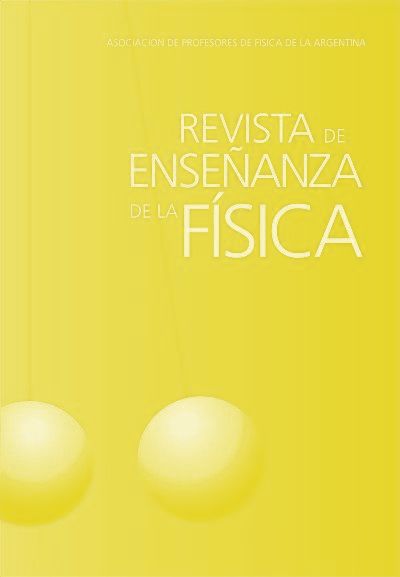An alternative proposal for interpreting two recurring misinterpretations in the relativistic mass-energy relationship
DOI:
https://doi.org/10.55767/2451.6007.v36.n2.47479Keywords:
Theory of Special Relativity, Teaching Physics, MisconceptionsAbstract
This essay explores two recurring mistakes commonly encountered in the teaching of the mass-energy relationship within the framework of the Special Theory of Relativity. Firstly, there are interpretations positing the possibility of converting mass into energy (and vice versa), and secondly, interpretations suggesting an equivalence or sameness between mass and energy. These conceptual misunderstandings are systematically dismantled through a meticulous historical-philosophical and conceptual analysis. Consequently, the aim is to empower educators and university professors with the means to preempt the perpetuation of these misguided notions. We advocate for an interpretive approach grounded in scholarly literature, drawing upon the seminal contributions of Warren, Martins, and Miller. Their scholarly endeavors furnish invaluable insights into the intricate fabric of the mass-energy relationship within the confines of the Special Theory of Relativity, underscored by the imperative of a nuanced and contextual comprehension of this foundational concept.
References
Bueno, O., & De Souza, E. G. (1996). The concept of quasi-truth. Logique et Analyse, 39(153/154), 183-199.
Da Costa, N. C. A. (1989). Logic and pragmatic truth. Studies in Logic and the Foundations of Mathematics, 126, 247-261.
Da Costa, N. C. A. (2018). O conhecimento científico. São Paulo: Paulus.
Da Costa, N. C. A., & French, S. (2003). Science and partial truth: A unitary approach to models and scientific reasoning. Oxford: Oxford University Press.
D’à Ottaviano, I. M. L., & Hifume, C. (2007). Peircean pragmatic truth and da Costa’s quasi-truth. In L. Magnani & P. Li (Eds.), Model-based reasoning in science, technology, and medicine (Vol. 64, pp. 553-591). Berlin, Heidelberg: Springer.
Einstein, A. (1905). Ist die Trägheit eines Körpers von seinem Energieinhalt abhängig? Annalen der Physik, 323(13), 639-641.
Einstein, A. (1907). Über das Relativitätsprinzip und die aus demselben gezogenen Folgerungen. Jahrbuch der Radioaktivität und Elektronik, 4, 411-462.
Fadner, W. L. (2008). Did Einstein really discover ‘‘E=mc²’’? American Journal of Physics, 56(2), 114-122.
French, A. P. (1968). Special relativity. New York: W. W. Norton & Company, Inc.
Gibbings, J. C. (2011). Dimensional analysis. London: Springer.
Hifume, C. (2003). A pragmatic theory of truth: Newton C.A. da Costa’s quasi-truth. Campinas: State University of Campinas.
Ives, H. (1952). Derivation of the mass-energy relation. Journal of the Optical Society of America, 42(8), 540-543.
Knight, R. D. (2023). Relativity. In Physics for scientists and engineers: A strategic approach (5th ed.). San Francisco: Pearson Addison-Wesley.
Langevin, P. (1913). L'inertie de l'énergie et ses conséquences. Journal de Physique Théorique et Appliquée, 3, 553-591.
Martins, R. A. (1989). A relação massa-energia e energia potencial. Caderno Catarinense de Ensino de Física, 15, 265-300.
Martins, R. A. (2012). Teoria da relatividade especial. Livraria da Física.
Martins, R. A. (2015). A origem histórica da relatividade especial. Livraria da Física.
Mikenberg, I., Da Costa, N. C. A., & Chuaqui, R. (1986). Pragmatic truth and approximation to truth. The Journal of Symbolic Logic, 51(1), 201-221.
Miller, A. (2007). Philosophy of language (2nd ed.). Montreal: McGill-Queen's University Press.
Nunes, R. C., & Queirós, W. P. (2020). Doze mitos sobre a teoria da relatividade que precisamos superar. Caderno Brasileiro de Ensino de Física, 37(2), 531-573.
Nunes, R. C., Queirós, W. P., & Cunha, J. A. R. (2022). Conceito de massa e a relação massa-energia no conteúdo de relatividade especial em livros didáticos de física. Revista de Enseñanza de la Física, 34(1), 8-20.
Planck, M. (1907). Zur Dynamik bewegter Systeme. Sitzungsberichte der Königlich Preussischen Akademie der Wissenschaften zu Berlin, 29, 542-570.
Poincaré, H. (1900). La théorie de Lorentz et le principe de réaction. Archives néerlandaises des sciences exactes et naturelles, 5, 252-278.
Poincaré, H. (1908). La dynamique de l’électron. Revue générale des sciences pures et appliquées, 19, 386-402.
Resnick, R. (1968). Introduction to special relativity. New York: John Wiley & Sons, Inc.
Stachel, J., & Torretti, R. (1982). Einstein’s first derivation of mass–energy equivalence. American Journal of Physics, 50(2), 760-763.
Thornton, S. T., & Rex, A. (2021). Modern physics for scientists and engineers (5th ed.). Boston: Cengage.
Warren, J. W. (1976). The mystery of mass-energy. Physics Education, 11(1), 52-54.
Published
Issue
Section
License

This work is licensed under a Creative Commons Attribution-NonCommercial-NoDerivatives 4.0 International License.
Aquellos autores/as que tengan publicaciones con esta revista, aceptan los términos siguientes:Los autores/as conservarán sus derechos de copiar y redistribuir el material, bajo los términos estipulados en la Licencia de reconocimiento, no comercial, sin obras derivadas de Creative Commons que permite a terceros compartir la obra bajo las siguientes condiciones:
- Reconocimiento — Debe reconocer adecuadamente la autoría, proporcionar un enlace a la licencia e indicar si se han realizado cambios. Puede hacerlo de cualquier manera razonable, pero no de una manera que sugiera que tiene el apoyo del licenciador o lo recibe por el uso que hace.
- NoComercial — No puede utilizar el material para una finalidad comercial.
- SinObraDerivada — Si remezcla, transforma o crea a partir del material, no puede difundir el material modificado.
- Los autores/as podrán adoptar otros acuerdos de licencia no exclusiva de distribución de la versión de la obra publicada (p. ej.: depositarla en un archivo telemático institucional o publicarla en un volumen monográfico) siempre que se indique la publicación inicial en esta revista.
- Se permite y recomienda a los autores/as difundir su obra a través de Internet (p. ej.: en archivos telemáticos institucionales o en su página web) antes y durante el proceso de envío, lo cual puede producir intercambios interesantes y aumentar las citas de la obra publicada. (Véase El efecto del acceso abierto).










